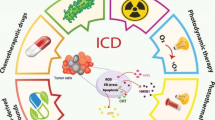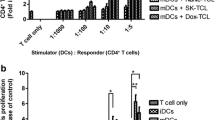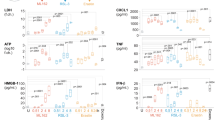Abstract
Immunogenic cell death is characterized by damage-associated molecular patterns, which can enhance the maturation and antigen uptake of dendritic cells. Shikonin, an anti-inflammatory and antitumor phytochemical, was exploited here as an adjuvant for dendritic cell-based cancer vaccines via induction of immunogenic cell death. Shikonin can effectively activate both receptor- and mitochondria-mediated apoptosis and increase the expression of all five tested damage-associated molecular patterns in the resultant tumor cell lysates. The combination treatment with damage-associated molecular patterns and LPS activates dendritic cells to a high maturation status and enhances the priming of Th1/Th17 effector cells. Shikonin-tumor cell lysate-loaded mature dendritic cells exhibit a high level of CD86 and MHC class II and activate Th1 cells. The shikonin-tumor cell lysate-loaded dendritic cell vaccines result in a strong induction of cytotoxic activity of splenocytes against target tumor cells, a retardation in tumor growth, and an increase in the survival of test mice. The much enhanced immunogenicity and efficacy of the current cancer vaccine formulation, that is, the use of shikonin-treated tumor cells as cell lysates for the pulse of dendritic cells in culture, may suggest a new ex vivo approach for developing individualized, dendritic cells-based anticancer vaccines.






Similar content being viewed by others
Abbreviations
- Bax:
-
Bcl-2–associated X protein
- Bcl-2:
-
B-cell lymphoma 2
- CRT:
-
Calreticulin
- DAMPs:
-
Damage-associated molecular patterns
- DC:
-
Dendritic cell
- DX:
-
Doxorubicin
- DX-TCL:
-
Doxorubicin-treated tumor cells as cell lysates
- ER:
-
Endoplasmic reticulum
- GM-CSF:
-
Granulocyte/macrophage-colony stimulatory factor
- GRP:
-
Glucose-related protein
- HMGB1:
-
High-mobility group protein box 1
- HSP:
-
Heat shock protein
- MHC:
-
Major histocompatibility complex
- MG:
-
MG-132
- MG-TCL:
-
MG-132-treated tumor cells as cell lysates
- RORγt:
-
Retinoic acid receptor-related orphan nuclear receptor gamma t
- SK:
-
Shikonin
- SK-TCL:
-
Shikonin-treated tumor cells as cell lysates
- Tbet:
-
Th1-specific T box transcription factor
- TCL:
-
Tumor cell lysate
- TLR4:
-
Toll-like receptor 4
- TNFα:
-
Tumor necrosis factor alpha
- TX:
-
Paclitaxel
- TX-TCL:
-
Paclitaxel-treated tumor cells as cell lysates
- XIAP:
-
X-linked inhibitor of apoptosis protein
References
Chen X, Yang L, Oppenheim JJ, Howard MZ (2002) Cellular pharmacology studies of shikonin derivatives. Phytother Res 16:199–209. doi:10.1002/ptr.1100
Staniforth V, Wang SY, Shyur LF, Yang NS (2004) Shikonins, phytocompounds from Lithospermum erythrorhizon, inhibit the transcriptional activation of human tumor necrosis factor alpha promoter in vivo. J Biol Chem 279:5877–5885. doi:10.1074/jbc.M309185200
Su PF, Staniforth V, Li CJ, Wang CY, Chiao MT, Wang SY, Shyur LF, Yang NS (2008) Immunomodulatory effects of phytocompounds characterized by in vivo transgenic human GM-CSF promoter activity in skin tissues. J Biomed Sci 15:813–822. doi:10.1007/s11373-008-9266-7
Chiu SC, Yang NS (2007) Inhibition of tumor necrosis factor-alpha through selective blockade of Pre-mRNA splicing by shikonin. Mol Pharmacol 71:1640–1645. doi:10.1124/mol.106.032821
Chiu SC, Tsao SW, Hwang PI, Vanisree S, Chen YA, Yang NS (2010) Differential functional genomic effects of anti-inflammatory phytocompounds on immune signaling. BMC Genomics 11:513. doi:10.1186/1471-2164-11-513
Lee HJ, Magesh V, Nam D, Lee EO, Ahn KS, Jung MH, Kim DK, Kim JY, Kim SH (2008) Shikonin, acetylshikonin, and isobutyroylshikonin inhibit VEGF-induced angiogenesis and suppress tumor growth in lewis lung carcinoma-bearing mice. Yakugaku zasshi: J Pharm Soc Jpn 128:1681–1688
Wang Z, Liu T, Gan L, Wang T, Yuan X, Zhang B, Chen H, Zheng Q (2010) Shikonin protects mouse brain against cerebral ischemia/reperfusion injury through its antioxidant activity. Eur J Pharmacol 643:211–217. doi:10.1016/j.ejphar.2010.06.027
Ko FN, Lee YS, Kuo SC, Chang YS, Teng CM (1995) Inhibition on platelet activation by shikonin derivatives isolated from Arnebia euchroma. Biochim Biophys Acta 1268:329–334
An S, Park YD, Paik YK, Jeong TS, Lee WS (2007) Human ACAT inhibitory effects of shikonin derivatives from Lithospermum erythrorhizon. Bioorg Med Chem Lett 17:1112–1116. doi:10.1016/j.bmcl.2006.11.024
Chang IC, Huang YJ, Chiang TI, Yeh CW, Hsu LS (2010) Shikonin induces apoptosis through reactive oxygen species/extracellular signal-regulated kinase pathway in osteosarcoma cells. Biol Pharm Bull 33:816–824
Yang H, Zhou P, Huang H et al (2009) Shikonin exerts antitumor activity via proteasome inhibition and cell death induction in vitro and in vivo. Int J Cancer 124:2450–2459. doi:10.1002/ijc.24195
Han W, Li L, Qiu S, Lu Q, Pan Q, Gu Y, Luo J, Hu X (2007) Shikonin circumvents cancer drug resistance by induction of a necroptotic death. Mol Cancer Ther 6:1641–1649. doi:10.1158/1535-7163.MCT-06-0511
Garg AD, Nowis D, Golab J, Vandenabeele P, Krysko DV, Agostinis P (2010) Immunogenic cell death, DAMPs and anticancer therapeutics: an emerging amalgamation. Biochim Biophys Acta 1805:53–71. doi:10.1016/j.bbcan.2009.08.003
Zitvogel L, Apetoh L, Ghiringhelli F, Kroemer G (2008) Immunological aspects of cancer chemotherapy. Nat Rev Immunol 8:59–73. doi:10.1038/nri2216
Tesniere A, Apetoh L, Ghiringhelli F, Joza N, Panaretakis T, Kepp O, Schlemmer F, Zitvogel L, Kroemer G (2008) Immunogenic cancer cell death: a key-lock paradigm. Curr Opin Immunol 20:504–511. doi:10.1016/j.coi.2008.05.007
Dhodapkar MV, Dhodapkar KM, Palucka AK (2008) Interactions of tumor cells with dendritic cells: balancing immunity and tolerance. Cell Death Differ 15:39–50. doi:10.1038/sj.cdd.4402247
Wen CC, Chen HM, Chen SS et al (2011) Specific microtubule-depolymerizing agents augment efficacy of dendritic cell-based cancer vaccines. J Biomed Sci 18:44. doi:10.1186/1423-0127-18-44
Steinman RM, Pope M (2002) Exploiting dendritic cells to improve vaccine efficacy. J Clin Invest 109:1519–1526. doi:10.1172/JCI15962
Takeda K, Kaisho T, Akira S (2003) Toll-like receptors. Annu Rev Immunol 21:335–376. doi:10.1146/annurev.immunol.21.120601.141126
Janeway CA Jr (1989) Approaching the asymptote? Evolution and revolution in immunology. Cold Spring Harb Symp Quant Biol 54(Pt 1):1–13
Matzinger P (1994) Tolerance, danger, and the extended family. Annu Rev Immunol 12:991–1045. doi:10.1146/annurev.iy.12.040194.005015
Kono H, Rock KL (2008) How dying cells alert the immune system to danger. Nat Rev Immunol 8:279–289. doi:10.1038/nri2215
Tait SW, Green DR (2010) Mitochondria and cell death: outer membrane permeabilization and beyond. Nat Rev Mol Cell Biol 11:621–632. doi:10.1038/nrm2952
Hong SJ, Dawson TM, Dawson VL (2004) Nuclear and mitochondrial conversations in cell death: PARP-1 and AIF signaling. Trends Pharmacol Sci 25:259–264. doi:10.1016/j.tips.2004.03.005
Casares N, Pequignot MO, Tesniere A et al (2005) Caspase-dependent immunogenicity of doxorubicin-induced tumor cell death. J Exp Med 202:1691–1701. doi:10.1084/jem.20050915
Jordan MA, Wendell K, Gardiner S, Derry WB, Copp H, Wilson L (1996) Mitotic block induced in HeLa cells by low concentrations of paclitaxel (Taxol) results in abnormal mitotic exit and apoptotic cell death. Cancer Res 56:816–825
Obeng EA, Carlson LM, Gutman DM, Harrington WJ Jr, Lee KP, Boise LH (2006) Proteasome inhibitors induce a terminal unfolded protein response in multiple myeloma cells. Blood 107:4907–4916. doi:10.1182/blood-2005-08-3531
Hong SH, Kim J, Kim JM, Lee SY, Shin DS, Son KH, Han DC, Sung YK, Kwon BM (2007) Apoptosis induction of 2′-hydroxycinnamaldehyde as a proteasome inhibitor is associated with ER stress and mitochondrial perturbation in cancer cells. Biochem Pharmacol 74:557–565. doi:10.1016/j.bcp.2007.05.016
Lomonosova E, Ryerse J, Chinnadurai G (2009) BAX/BAK-independent mitoptosis during cell death induced by proteasome inhibition? Mol Cancer Res 7:1268–1284. doi:10.1158/1541-7786.MCR-08-0183
Kepp O, Senovilla L, Galluzzi L, Panaretakis T, Tesniere A, Schlemmer F, Madeo F, Zitvogel L, Kroemer G (2009) Viral subversion of immunogenic cell death. Cell Cycle 8:860–869
Hsu PC, Huang YT, Tsai ML, Wang YJ, Lin JK, Pan MH (2004) Induction of apoptosis by shikonin through coordinative modulation of the Bcl-2 family, p27, and p53, release of cytochrome c, and sequential activation of caspases in human colorectal carcinoma cells. J Agric Food Chem 52:6330–6337. doi:10.1021/jf0495993
Ruan M, Yan M, Yang WJ, Qu XZ, Zhou XJ, Chen WT, Zhang CP (2010) Role of NF-kappaB pathway in shikonin induced apoptosis in oral squamous cell carcinoma Tca-8113 cells. Shanghai J Stomatol 19:66–71
Shi M, Xiang J (2006) CD4+ T cell-independent maintenance and expansion of memory CD8+ T cells derived from in vitro dendritic cell activation. Int Immunol 18:887–895. doi:10.1093/intimm/dxl025
Pavelko KD, Heckman KL, Hansen MJ, Pease LR (2008) An effective vaccine strategy protective against antigenically distinct tumor variants. Cancer Res 68:2471–2478. doi:10.1158/0008-5472.CAN-07-5937
Staniforth V, Chiu LT, Yang NS (2006) Caffeic acid suppresses UVB radiation-induced expression of interleukin-10 and activation of mitogen-activated protein kinases in mouse. Carcinogenesis 27:1803–1811. doi:10.1093/carcin/bgl006
Jung MY, Son MH, Kim SH, Cho D, Kim TS (2011) IL-32gamma induces the maturation of dendritic cells with Th1- and Th17-polarizing ability through enhanced IL-12 and IL-6 production. J Immunol 186:6848–6859. doi:10.4049/jimmunol.1003996
Blomberg K, Granberg C, Hemmila I, Lovgren T (1986) Europium-labelled target cells in an assay of natural killer cell activity. I. A novel non-radioactive method based on time-resolved fluorescence. J Immunol Methods 86:225–229
Ott M, Norberg E, Zhivotovsky B, Orrenius S (2009) Mitochondrial targeting of tBid/Bax: a role for the TOM complex? Cell Death Differ 16:1075–1082. doi:10.1038/cdd.2009.61
Ashe PC, Berry MD (2003) Apoptotic signaling cascades. Prog Neuropsychopharmacol Biol Psychiatry 27:199–214. doi:10.1016/S0278-5846(03)00016-2
Hsu YT, Youle RJ (1997) Nonionic detergents induce dimerization among members of the Bcl-2 family. J Biol Chem 272:13829–13834
Yethon JA, Epand RF, Leber B, Epand RM, Andrews DW (2003) Interaction with a membrane surface triggers a reversible conformational change in Bax normally associated with induction of apoptosis. J Biol Chem 278:48935–48941. doi:10.1074/jbc.M306289200
Antonsson B, Montessuit S, Lauper S, Eskes R, Martinou JC (2000) Bax oligomerization is required for channel-forming activity in liposomes and to trigger cytochrome c release from mitochondria. Biochem J 345(Pt 2):271–278
Antonsson B, Montessuit S, Sanchez B, Martinou JC (2001) Bax is present as a high molecular weight oligomer/complex in the mitochondrial membrane of apoptotic cells. J Biol Chem 276:11615–11623. doi:10.1074/jbc.M010810200
Gonzalez-Gronow M, Selim MA, Papalas J, Pizzo SV (2009) GRP78: a multifunctional receptor on the cell surface. Antioxid Redox Signal 11:2299–2306. doi:10.1089/ARS.2009.2568
Al-Hashimi AA, Caldwell J, Gonzalez-Gronow M et al (2010) Binding of anti-GRP78 autoantibodies to cell surface GRP78 increases tissue factor procoagulant activity via the release of calcium from endoplasmic reticulum stores. J Biol Chem 285:28912–28923. doi:10.1074/jbc.M110.119107
Obeid M, Tesniere A, Ghiringhelli F et al (2007) Calreticulin exposure dictates the immunogenicity of cancer cell death. Nat Med 13:54–61. doi:10.1038/nm1523
Chaput N, De Botton S, Obeid M, Apetoh L, Ghiringhelli F, Panaretakis T, Flament C, Zitvogel L, Kroemer G (2007) Molecular determinants of immunogenic cell death: surface exposure of calreticulin makes the difference. J Mol Med (Berl) 85:1069–1076. doi:10.1007/s00109-007-0214-1
Lasunskaia EB, Fridlianskaia I, Arnholdt AV, Kanashiro M, Guzhova I, Margulis B (2010) Sub-lethal heat shock induces plasma membrane translocation of 70-kDa heat shock protein in viable, but not in apoptotic, U-937 leukaemia cells. Acta Pathol Microbiol Immunol Scand 118:179–187. doi:10.1111/j.1600-0463.2009.02576.x
Spisek R, Charalambous A, Mazumder A, Vesole DH, Jagannath S, Dhodapkar MV (2007) Bortezomib enhances dendritic cell (DC)-mediated induction of immunity to human myeloma via exposure of cell surface heat shock protein 90 on dying tumor cells: therapeutic implications. Blood 109:4839–4845. doi:10.1182/blood-2006-10-054221
Datta R, Oki E, Endo K, Biedermann V, Ren J, Kufe D (2000) XIAP regulates DNA damage-induced apoptosis downstream of caspase-9 cleavage. J Biol Chem 275:31733–31738. doi:10.1074/jbc.M910231199
Yuan BZ, Chapman JA, Reynolds SH (2008) Proteasome inhibitor MG132 induces apoptosis and inhibits invasion of human malignant pleural mesothelioma cells. Transl Oncol 1:129–140
Meylan E, Tschopp J, Karin M (2006) Intracellular pattern recognition receptors in the host response. Nature 442:39–44. doi:10.1038/nature04946
Seong SY, Matzinger P (2004) Hydrophobicity: an ancient damage-associated molecular pattern that initiates innate immune responses. Nat Rev Immunol 4:469–478. doi:10.1038/nri1372
Korbelik M, Zhang W, Merchant S (2011) Involvement of damage-associated molecular patterns in tumor response to photodynamic therapy: surface expression of calreticulin and high-mobility group box-1 release. Cancer Immunol Immunother 60:1431–1437. doi:10.1007/s00262-011-1047-x
Basu S, Binder RJ, Ramalingam T, Srivastava PK (2001) CD91 is a common receptor for heat shock proteins gp96, hsp90, hsp70, and calreticulin. Immunity 14:303–313
Iezzi G, Sonderegger I, Ampenberger F, Schmitz N, Marsland BJ, Kopf M (2009) CD40-CD40L cross-talk integrates strong antigenic signals and microbial stimuli to induce development of IL-17-producing CD4+ T cells. Proc Natl Acad Sci USA 106:876–881. doi:10.1073/pnas.0810769106
Lee YK, Turner H, Maynard CL, Oliver JR, Chen D, Elson CO, Weaver CT (2009) Late developmental plasticity in the T helper 17 lineage. Immunity 30:92–107. doi:10.1016/j.immuni.2008.11.005
Muranski P, Boni A, Antony PA et al (2008) Tumor-specific Th17-polarized cells eradicate large established melanoma. Blood 112:362–373. doi:10.1182/blood-2007-11-120998
Acknowledgments
This present work was sponsored by the Grant (NSC-097-2320-B-001-012) from the National Science Council, Taiwan and the Grant (99-Academia Sinica Investigator Award-12) from Academia Sinica, Taiwan. We thank Heiko Kuhn, Miranda Jane Loney, and Ruth Giodan for manuscript editing.
Conflict of interest
The authors declare that they have no conflict of interest.
Author information
Authors and Affiliations
Corresponding author
Electronic supplementary material
Below is the link to the electronic supplementary material.


Rights and permissions
About this article
Cite this article
Chen, HM., Wang, PH., Chen, SS. et al. Shikonin induces immunogenic cell death in tumor cells and enhances dendritic cell-based cancer vaccine. Cancer Immunol Immunother 61, 1989–2002 (2012). https://doi.org/10.1007/s00262-012-1258-9
Received:
Accepted:
Published:
Issue Date:
DOI: https://doi.org/10.1007/s00262-012-1258-9




